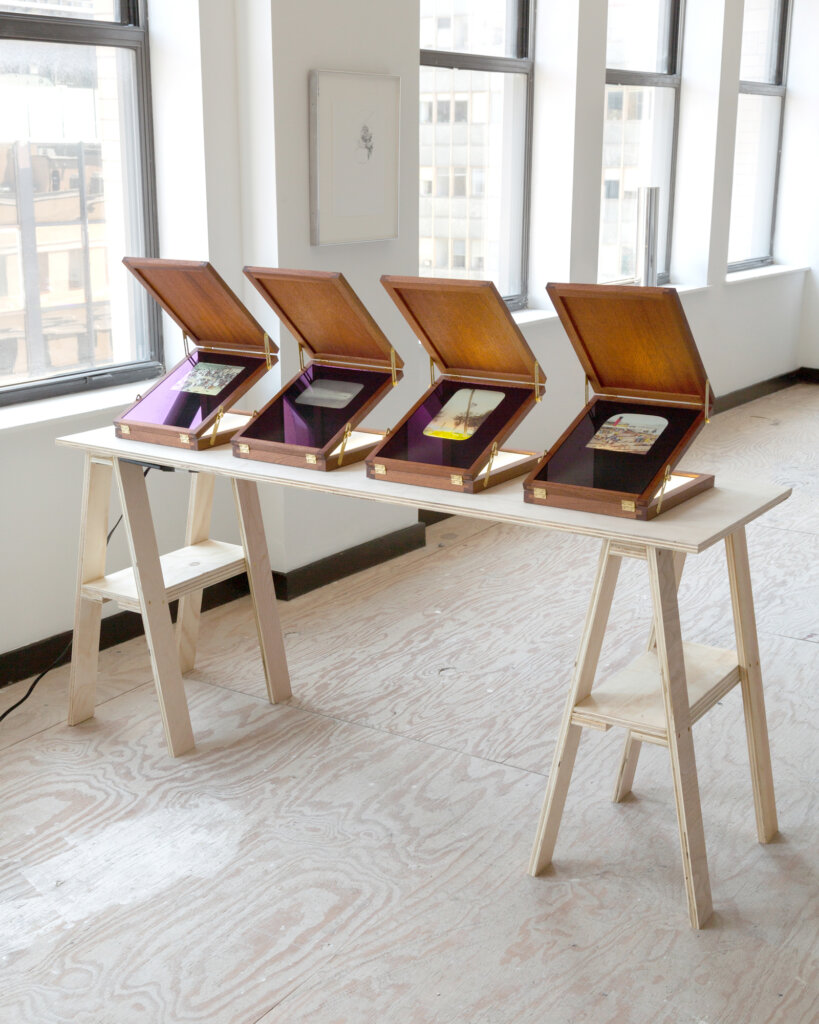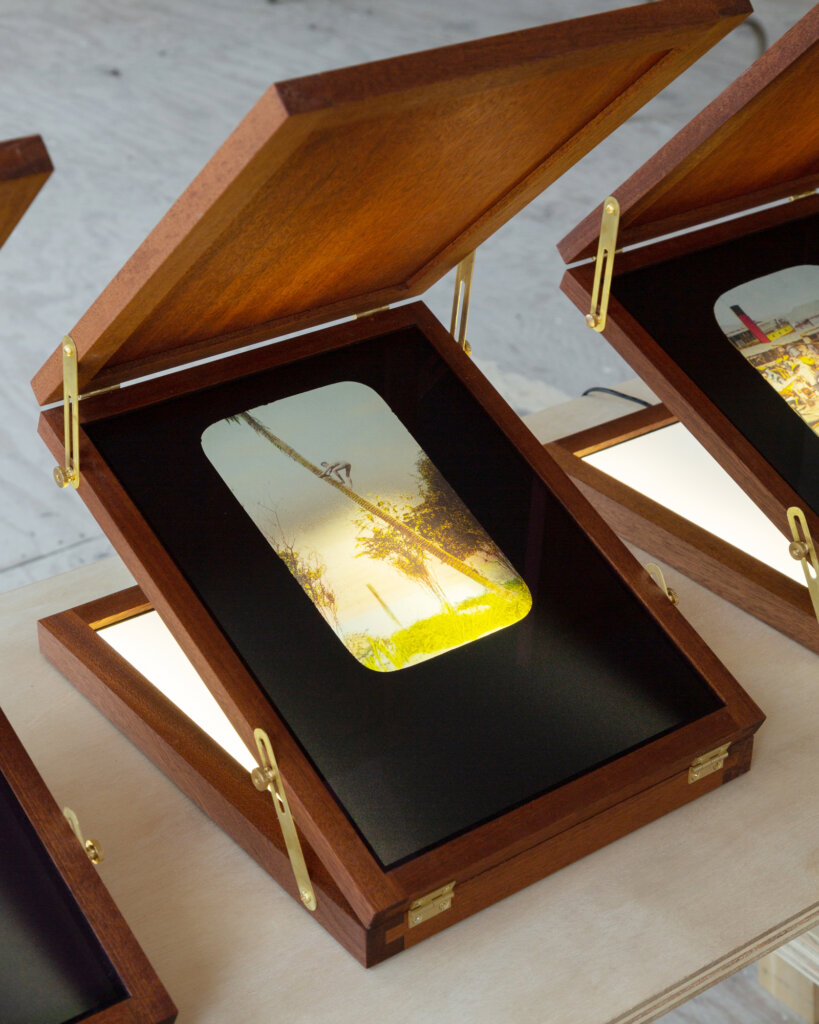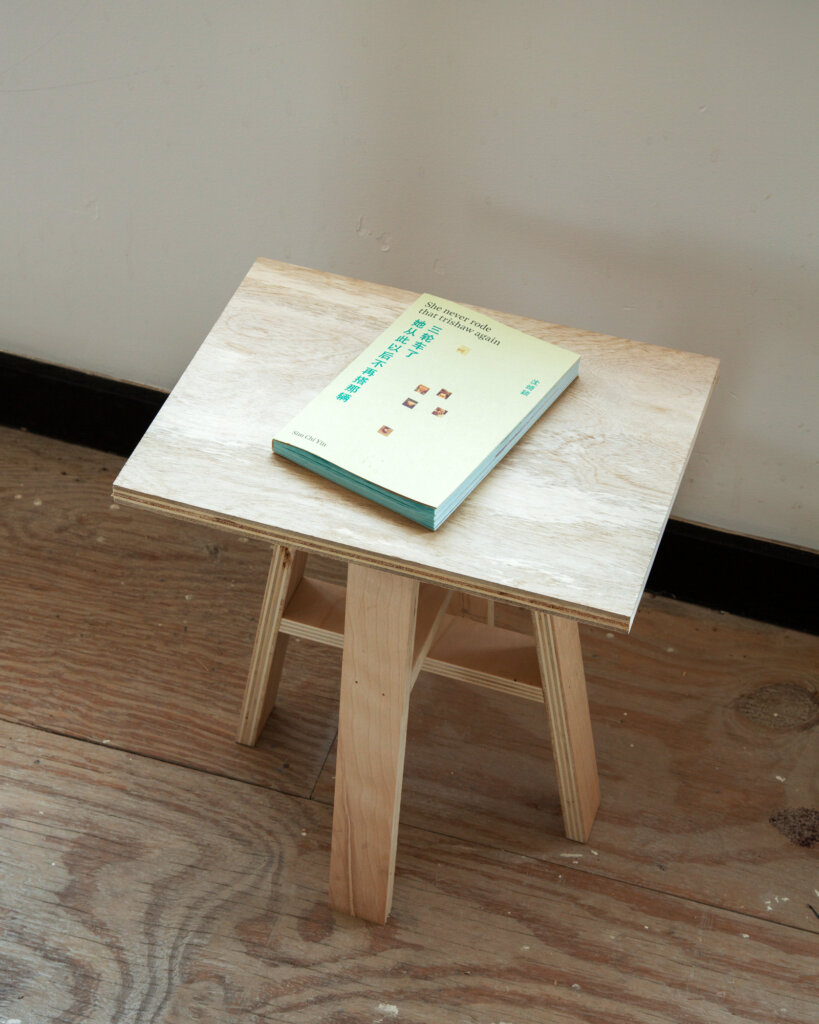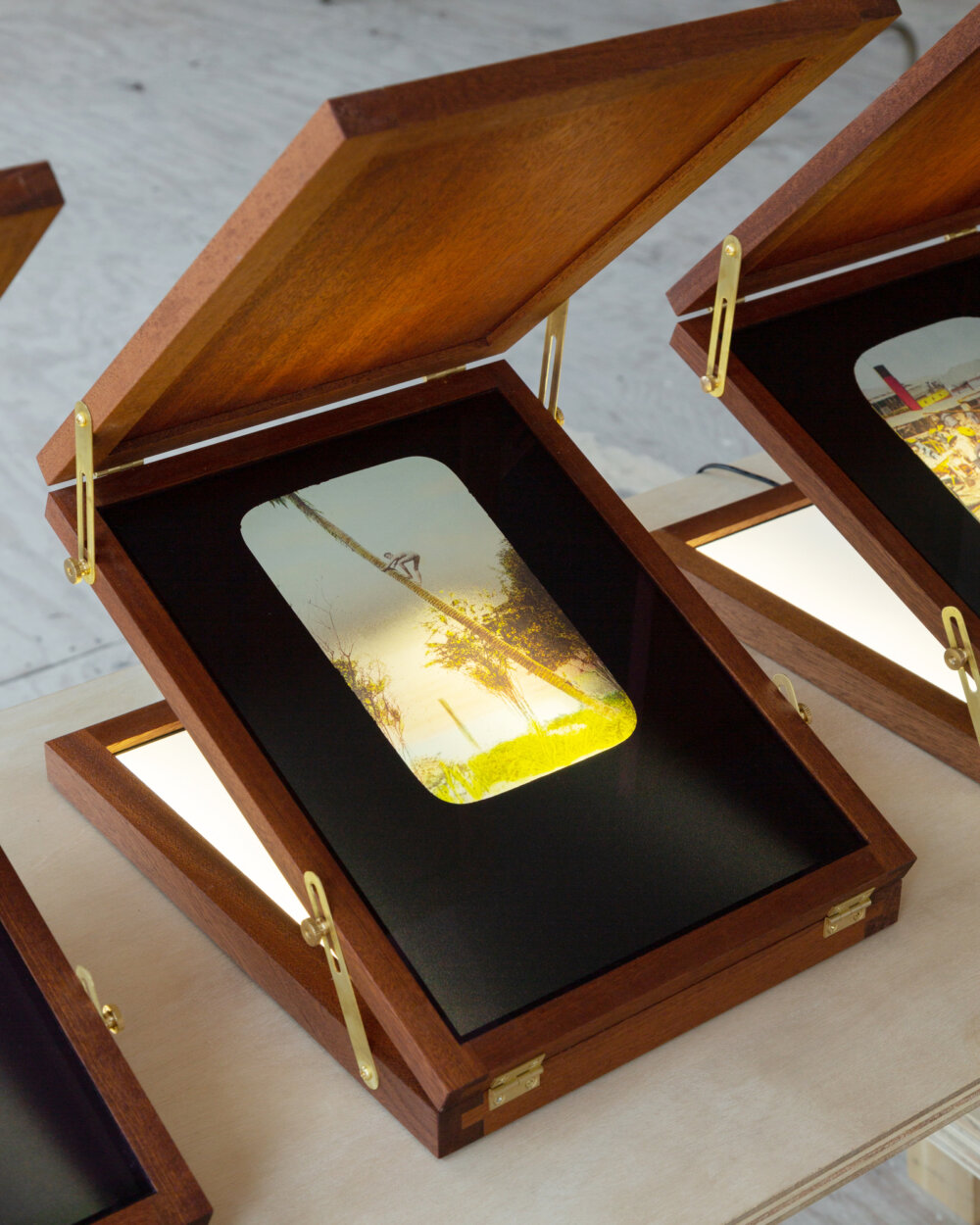I first became interested in Magic Lantern slides in learning through @gabbymoser’s scholarship about how they were a colonial pedagogical tool — specifically, they were used in a series of eight lectures cast as geography lessons to teach pupils around the British empire about its colonies. I became interested in what was inscribed in those images, and how I could repurpose the imagery and the technology, away from its colonial application. I collected a body of lantern slides from the late 1800s and early 1900s and created interventions in them, to make the 40 glass plates in “The Suitcase Is A Little Bit Rotten” series, on a commission for Autograph ABP. I am displaying them on replicas of vintage retouching stands used in the early 1900s to hand-tint or touch up glass negatives, upgrading them to a lightbox .
In The Mountain That Hid, Sim Chi Yin sets up a camera in the mouth of an old railroad tunnel in Singapore, attempting to retrace the steps of her grandfather’s deportation from Malaya to China in 1949 during the anti-colonial war in the former British territory. The left half of the video diptych shows the view from that inside cavernous space looking out onto the jungle beyond. We hear indistinguishable voices that get closer and then a group of hiking middle-aged women unwittingly come out of the woods and into frame, taking selfies and chatting in Mandarin. Gradually, they realize they are being filmed and what results is an unexpected reality TV-style run-in captured on camera. Their unguarded, gossipy conversation hits uncanny notes on the presence of the filmmaker and on time travel.
As this unscripted drama unfolds on the left, the right side slowly shuttles through a series of almost-still close-up videos, beginning with a lung-like spider web undulating in the wind. Evocative, the images show interiors of Sim’s ancestral house in Meixian, Guangdong province, southern China, a home her grandfather lived in after being deported and shortly before being executed nearby — a fate alluded to with the closing scene of a pig struggling to breathe.
This short film with two different registers of time also alludes to the movement of the Chinese diaspora between China and Southeast Asia. During the Cold War, colonial Britain used “emergency” powers to send Sim’s grandfather and over 30,000 mostly Chinese Malayans “back” to China based purely on ethnicity – despite many of them having been born in the colony – while present-day economics has sent waves of mainland Chinese like those Sim met in the tunnel the other way, to Southeast Asia. In a related performance lecture[1], Sim asks aloud: “Does history write itself in a line, or in circles?”
The Mountain that Hid is part of Sim’s larger, ten-year project[2] focusing on the public memory of the anti-colonial war in Malaya, euphemistically named by the British the “Malayan Emergency”, spanning 1948-60, and the broader anti-colonial resistance by the Malayan National Liberation Army (MNLA) to the British forces in modern-day Malaysia and Singapore. Her reckoning[3] with this conflict emerged out of a desire to end silence around the disappearance and death of her paternal grandfather, a newspaper editor and educator who, she would learn, was forcibly separated from the family, extradited by the British to China, and killed by Chinese Nationalist Party soldiers in 1949 – part of a wider push by the British colonial authorities to deport and detain Malayans suspected of being Communist at the time.
The conversation with Sim’s ancestors continues the next suite of work, The Suitcase Is A Little Bit Rotten, a series of photographic interventions using found imagery, namely Magic Lantern Slides from the late 1800s and early 1900s. Drawing from a set of over 40 glass plates she’s made, Sim exhibits these altered, hand-painted lantern slides on stands used to retouch glass negatives reminiscent of the historical equipment contemporary with this photo technology. She’s updated them to lightboxes.
Here we encounter a different kind of run-in, no less constituted by a visual convergence of the colonial gaze and the subjectivities of the colonized, playing again with the tension between the evidence and its ongoing interpretation. Sim’s interest in magic lantern slides was sparked by reading about the British colonial project that deployed lantern slideshows across its empire in a set of choreographed geography lectures to students.[4]
The first group of found lantern slides Sim uses establish the historical mise-en-scene, with landscapes meant to advertise the colony of Malaya produced by the “Malayan Information Agency”, the British government’s propaganda arm around its colony, from 1928 to 1952. Other more generic lantern slide images of Southeast Asia continue to flesh out the colonial gaze, including schools, plantations and scenes of daily commerce, indigenous people who were forced into colonial subjugation. Some of these came from the Methodist Episcopal Church of New York and were slide lectures to prepare American missionaries for their time in Southeast Asia.
Taking a speculative turn while considering the continuity of family narratives, Sim grafts the image of her young child and her disappeared grandfather into these found magic lantern slide images. While they could never meet in real life, the lineage and connection between Sim’s child and grandfather is enacted in this highly constructed–if not already fabulist–visual space of colonial projection.
Sim opens the series with an image of a comet jettisoning through the darkness, evoking the mysterious links between the womb and moon. In the fullest version of the series, the 3D in utero scan of her child follows, sequenced within more images of the cosmos, until a goose flies and drops the crying newborn into the dark void of the world. Then come the Southeast Asian landscapes, complete with ports, rickshaws and trishaws, lush jungles and pendulous palms; British colonial schools, Western architecture, colonial maps imposed on the populace and the land. Racist caricatures of indigenous people in the region are thrown into the mix, more images of 19th century astronomy, interspersed with more hazy images of her child’s skin and spinal column.
In the first slide shown in this exhibition, a scene of Malays congregate on a street in Malaya and Sim’s grandfather, stands in the background, arms resting on his hips, near but not of the crowd. The portrait of him she uses in the lantern slide was the first she had ever encountered, in her thirties. She considers the transposition a kind of leap of faith, a depiction of a social gathering he could have imaginably been part of, a fictional yet plausible historiography. As the sole Chinese figure in this scene among Malays, racialized power dynamics preside over the image which, as she asserts, originated with the British colonial administration’s divide and rule policies. These racialized politics that still govern Malaysia today – just one sign of the longue durée of colonialism.
In another slide, a young man demonstrates how to climb a tall coconut palm, his figure addressing the camera. Further down the trunk Sim’s baby climbs and follows, unaware of potential dangers. In a color-saturated background, his figure is left black and white and the baby is in high-resolution color. These cues point to the alterations of the slides, which Sim uses as sites of time travel.
Later in the series, figures in bright yellow straw hats at Hong Kong harbor in the early 1900s depict a typical scene of Southeast Asian daily economic life, with boats that serve as a metonymic shorthand for grandfather’s deportation – of which there is no visual archival record. Once again, away from the fray, he haunts the scene, standing on a ship above them, apparition-like.
An artist discovers traumas of her family story, traumas which are also collectively held. Now as a parent, she considers how one might parcel out such a family story to their child, how the child is implicated in this learning. The process mirrors the transgenerational processes of forgetting and remembering, to which photography is a prosthetic body, a mnemonic support. How do we choose to confront shared historical trauma, narrate atrocity, and come into a fuller accounting of the effects of transnational political oppression? Under-histories, counter-narratives, the previously silenced narratives must be heard and seen. And, as Sim’s poetic craftwork offers, the assimilation of past horrors also begs for the courage of imagination.
- Cora Fisher
[1] Sim Chi Yin, Methods of Memory: Time Travels in the Archives, at Asia Art Archive in America, New York, 2 December 2022, video documentation, https://www.aaa-a.org/programs/sim-chi-yin-methods-of-memory-time-travels-in-the-archives
[2] Lotte Laub, Sim Chi Yin, Maaza Mengiste, Sam I-shan, One Day We’ll Understand, catalog, Zilberman Gallery, 2021. Available at: https://www.zilbermangallery.com/images/publications/2046550472808769422.pdf
[3] Tash Aw, “Personal Histories”, New York Review of Books, 11 May 2023 issue, https://www.nybooks.com/articles/2023/05/11/personal-histories-sim-chi-yin/
[4] Gabrielle Moser, Projecting Citizenship: Photography and Belonging in the British Empire, Pennsylvania: The Pennsylvania State University Press: 2019.




